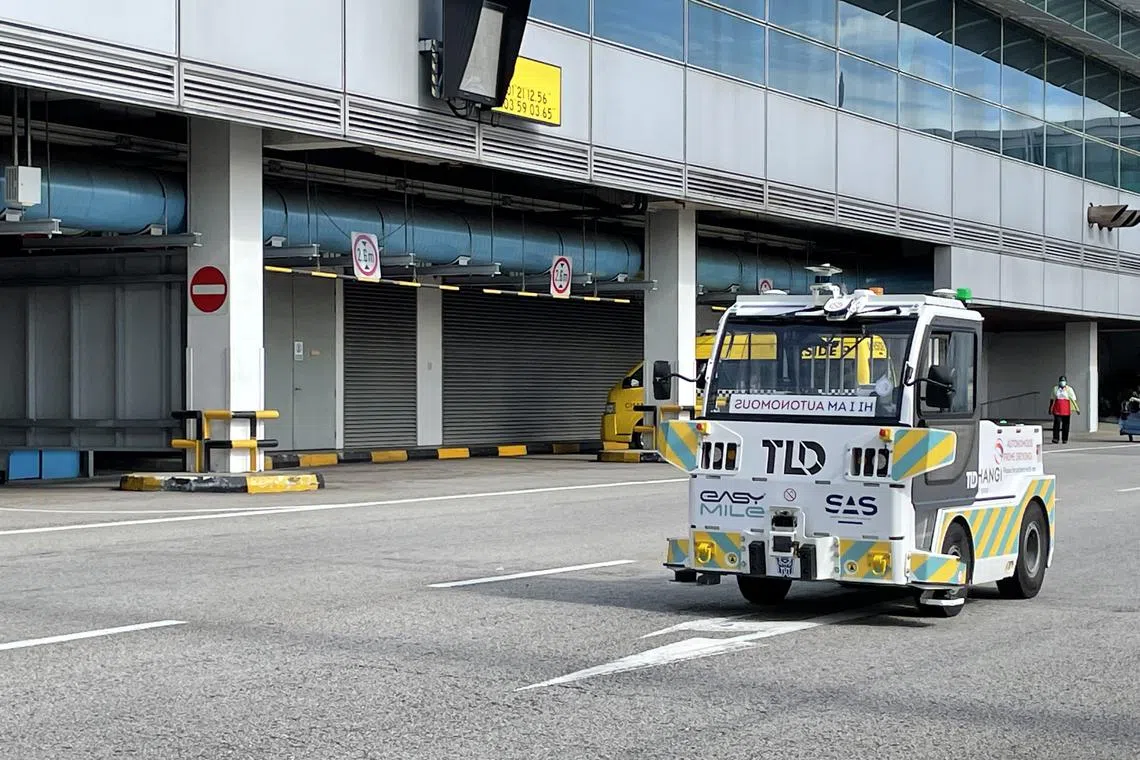5G trial at Changi Airport with self-driving vehicles, HD video inspection
Sign up now: Get ST's newsletters delivered to your inbox

The airport is testing autonomous vehicles (AVs) to move baggage while operators monitor their progress remotely, which will help to raise productivity.
PHOTO: CHANGI AIRPORT GROUP
Follow topic:
SINGAPORE - Changi Airport is testing the use of autonomous vehicles (AVs) to move baggage, and high-definition video-streaming to inspect aircraft, as part of a two-year 5G trial with Singtel.
The trial also aims to improve predictions on how long an aircraft takes to get ready for take-off.
The 5G makeover happening in parts of the airport was announced by the Changi Airport Group (CAG), Civil Aviation Authority of Singapore (CAAS) and network provider Singtel in a joint statement on Friday.
The findings from the test will pave the way for the deployment of 5G across Changi Airport in its entirety, according to the statement.
The 5G Aviation Testbed, which began in March, will involve only the baggage handling zone and the areas where aircraft are parked and maintained at Changi Airport Terminal 3.
Companies that operate in these areas can use 5G to test and adopt new solutions to boost productivity for aircraft ground operations and maintenance services, among others.
These services can tap the faster speeds and capacity of 5G, which can support real-time operations in a safer way, with little to no lag.
The airport is testing AVs to move baggage while operators monitor their progress remotely, which will help to raise productivity, said the statement.
At present, baggage tractors move luggage between the aircraft and the baggage handling area, and comprise the largest fleet of vehicles at the airside, said CAG in a separate statement.
Automating this process allows the airport to redesign the job scope of its workers to focus on more complicated tasks.
The network will also help speed up the transfer of flight-related data such as the latest weather and airport information to airline operators.
Currently, data transfer occurs only when the aircraft is docked and connected with cables to the airport’s Wi-Fi system. Now, as part of the trial, Singapore Airlines aircraft will use 5G wireless data transmission, doing away with the need for cables.
This will cut down the preparation time and reduce the number of fibre optic cables needed to facilitate data transfers.
No aircraft modification is needed as the data exchanges are wireless. Aircraft parked at adjacent stands will also be able to receive data coverage, which was previously not feasible, said the airport group.
The airport is also exploring new ways to inspect aircraft remotely, as well as use video analytics and artificial intelligence to predict aircraft turnaround time and flight timings more accurately.
The joint statement said: “The 5G Aviation Testbed will raise the airport’s AV capabilities to a higher level, allowing the continuous monitoring of AV operations in real time, using high-definition video streams with low latency and high transmission stability, such that operators can supervise AV operations remotely.”
Singtel has already upgraded the network of nearly 4,000 Singtel corporate mobile users to 5G as part of the trial, and will extend its 5G network coverage to public areas across the terminals by the end of 2025.
CAAS director-general Han Kok Juan said that the use of 5G is key for the airport’s long-term projects, which were started during the Covid-19 pandemic when there were fewer travellers.
“The 5G Aviation Testbed is a critical enabler for many of these initiatives and will help boost our air hub’s operational capabilities,” he said.
Aviation companies keen to build 5G solutions at the airport can seek funding under the Aviation Development Fund,
The airport, which hosts more than 90 airlines and sees 5,500 weekly flights, is the latest transport centre to have a 5G revamp. It follows the announcement of a 5G network for an automated port in Tuas,
Correction note: An earlier version of the story said the 5G Aviation Testbed will involve only Changi Airport Terminal 3 airside operations – works on the runway, taxiways and aircraft shelters outside the terminal. Changi Airport Group has clarified that it will only involve the baggage handling area and the areas where aircraft are parked at Terminal 3.

